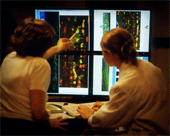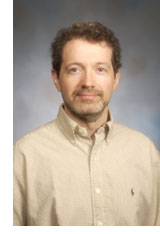You are here:
Research
- Office Overview
- Biodata Mining and Discovery Section
- Career Development Section
- Engineering and Instrumentation Unit
- Flow Cytometry Section
- Laboratory Animal Care and Use Section
- Light Imaging Section
- Macromolecular Biophysics Section
- Translational Immunology Section


Career Development Section
Chief, Career Development Section
Phone: 301-402-6924
Fax: 301-480-4871
Building: 10, Room: 6N216
E-mail: cerritem@mail.nih.gov
Mario Cerritelli received his B.S. in chemistry and zoology from Rutgers University. After receiving a Ph.D. in molecular biology and biochemistry from State University of New York at Stony Brook, he joined LSBR-NIAMS as an IRTA Fellow and subsequently became a staff scientist. In May 2002, he accepted the position of Chief of the NIAMS Career Development Section but still maintains an active profile in the LSBR.
Dr. Cerritelli is interested in bacteriophage structure and assembly. Three aspects of these studies are as follows: (i) he and his colleagues have investigated the T7 bacteriophage capsid and its organization of encapsidated DNA. Like other bacteriophages, T7 first forms a procapsid that undergoes a series of changes in becoming a mature capsid. In his thesis work with W. Studier at Brookhaven, Dr Cerritelli demonstrated that expression of capsid and scaffolding protein in the absence of other viral functions were sufficient to efficiently assemble procapsids, and that if the connector protein was also expressed, these procapsids underwent maturation. Upon joining the LSBR, he was lead investigator in a project that demonstrated that the double-stranded DNA of the T7 chromosome is coiled around the axis that passes through the portal vertex, in six tightly packed coaxial shells. (ii) He investigated the tail fiber proteins of bacteriophage T4 which determine the host-range specificity of this virus. Specifically, they demonstrated that these proteins are trimers, characterized their domain structures, and proposed a triple-stranded beta-helical model that has since been confirmed by crystallography as forming at least part of these molecules. (iii) Most recently Dr. Cerritelli has focused on the fold and properties of lambda-phage protein gpD, which binds to the outer surface of the capsid shell, thereby stabilizing it. The crystal structure of gpD was solved by colleagues in the NCI and cryo-EM analysis in the LSBR demonstrated that on capsids, gpD is trimeric and both its N and C termini are located on the same side of the gpD trimer, juxtaposed with the underlying capsid surface. Current experiments are intended to further elucidate and exploit these interactions.
Other NIAMS Affiliations
Laboratory of Structural Biology ResearchOffice of Science and Technology
Selected Publications
Cerritelli ME, Trus BL, Smith CS, Cheng N, Conway JF, Steven AC. A second symmetry mismatch at the portal vertex of bacteriophage T7: 8-fold symmetry in the procapsid core. J Mol Biol. 2003; 327(1):1-6.

Yang F, Forrer P, Dauter Z, Conway JF, Cheng N, Cerritelli ME, Steven AC, Pluckthun A, Wlodawer A. Novel fold and capsid-binding properties of the lambda-phage display platform protein gpD. Nat Struct Biol. 2000; 7(3):230-7.

Miroshnikov KA, Marusich EI, Cerritelli ME, Cheng N, Hyde CC, Steven AC, Mesyanzhinov VV. Engineering trimeric fibrous proteins based on bacteriophage T4 adhesins. Protein Eng. 1998; 11(4):329-32.

Frank EG, Cheng N, Do CC, Cerritelli ME, Bruck I, Goodman MF, Egelman EH, Woodgate R, Steven AC. Visualization of two binding sites for the Escherichia coli UmuD'(2)C complex (DNA pol V) on RecA-ssDNA filaments. J Mol Biol. 2000; 297(3):585-97.

Cerritelli ME, Conway JF, Cheng N, Trus BL, Steven AC. Molecular mechanisms in bacteriophage T7 procapsid assembly, maturation, and DNA containment. Adv Protein Chem. 2003; 64:301-23.




